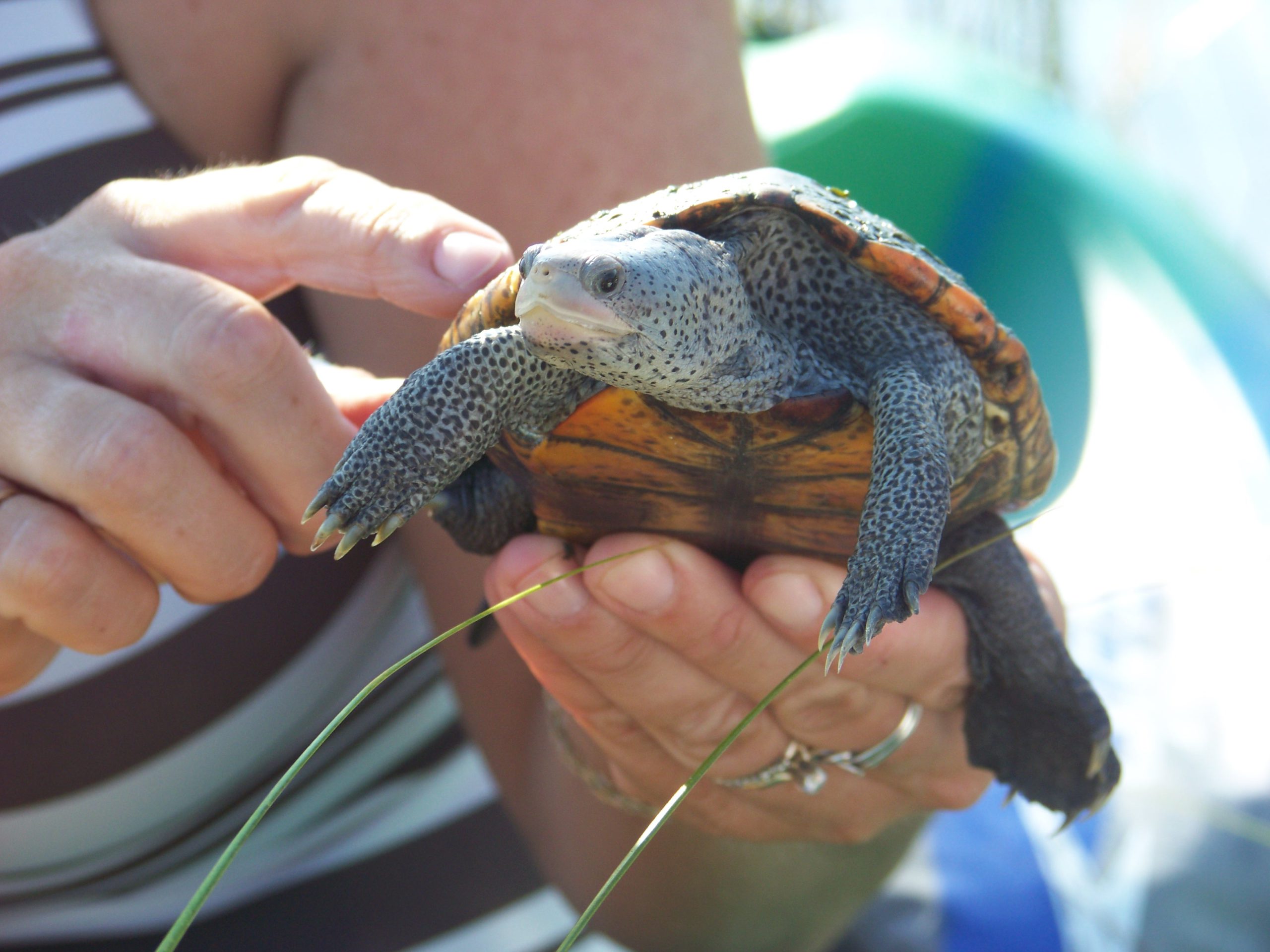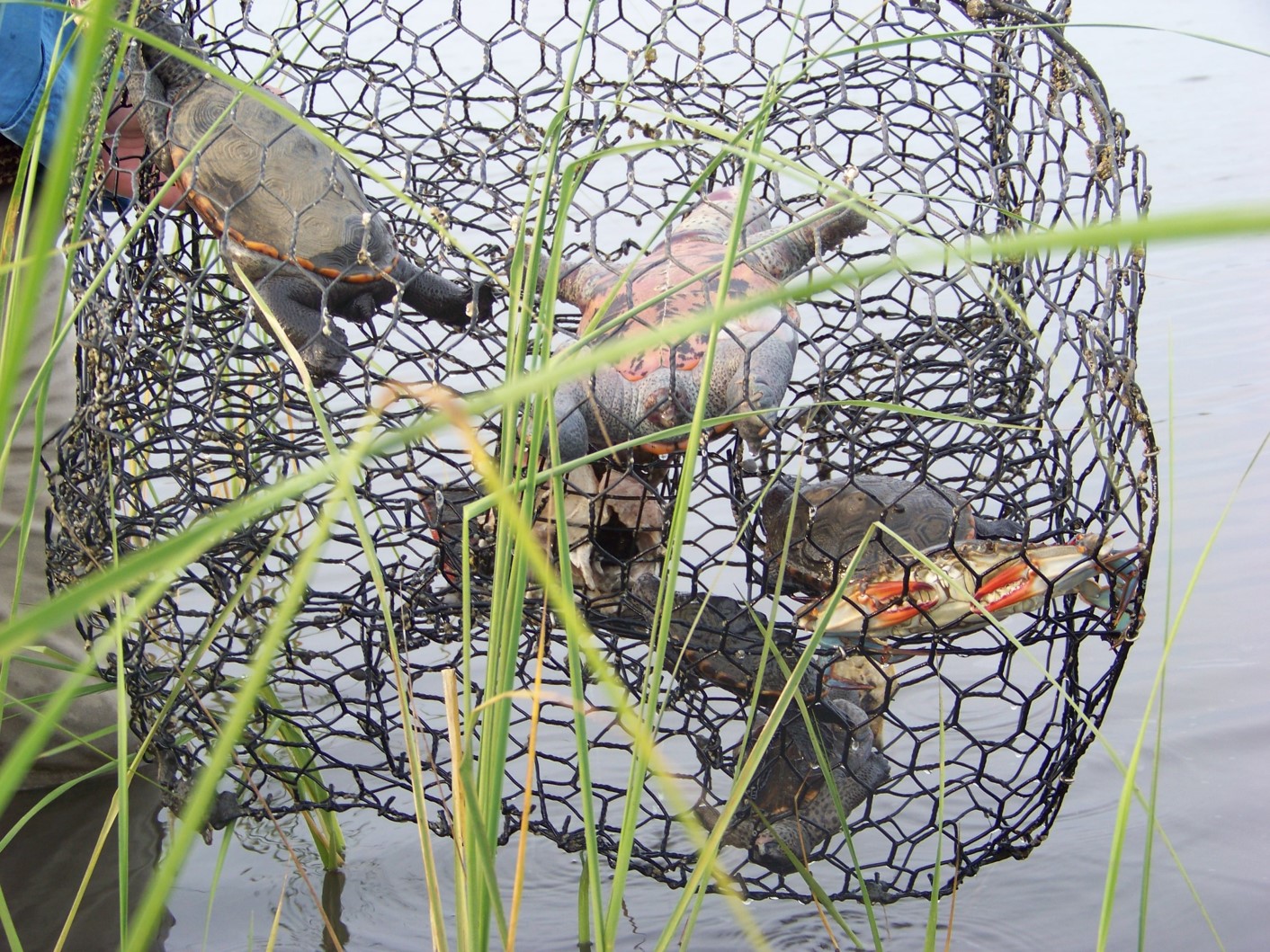Another metric of a healthy estuary is the diversity and abundance of fish and wildlife. Estuaries are teeming with a variety of benthic creatures like annelids worms, mollusk, and crustaceans. I have personally collected 101 species of fish from Pensacola Bay, and I am sure there are more. And the variety of shore and seabirds attracts birders from all around. Several of these species support commercial and recreational fisheries that in some cases, are the key to the community’s economic stability. Florida Sea Grant has focused its fish and wildlife monitoring efforts on estuarine fish and wildlife that were once abundant in the Pensacola Bay system but have now declined. Diamondback terrapins are one of them.

Photo: Molly O’Connor
Diamondback terrapins are the only estuarine turtle in the United States. A member of the Family Emyididae, they are related to common pond turtles like sliders and cooters. They differ from their freshwater cousins in that they have lacrimal glands in their eyes to expel salt from the water they drink, allowing them to live in more saline water. Their glands are not as efficient as sea turtles, so they cannot tolerate seawater and thus are restricted to estuaries.
Their habitat of preference are salt marshes, though in south Florida they are found in mangrove swamps. They spend their lives in these marshes and do not migrate as sea turtles do. They can be found basking in the sun, swimming in the lagoons, or buried in the mud of this habitat. They feed on shellfish, consuming such creatures as fiddler crabs, clams, and snails. The marsh periwinkle is a particular favorite throughout their range.
Breeding takes place in the spring usually within the lagoons of the marsh. The females then swim into the open bay seeking high dry beaches to lay her eggs. Unlike sea turtles, she prefers to nest during daylight hours, the sunnier the better. Her clutch of 10 or so eggs will hatch in 60-70 days and the hatchlings, again unlike sea turtles, head inland and not to the open water. Here they hide and feed until eventually they become more aquatic.
This turtle is quite abundant along the Mid-Atlantic states where it is the mascot for the University of Maryland. But along Florida’s shores it is not often seen. It is not known whether their populations in our state have always been small, or whether they are just good at avoiding us. Either way, they not well known here and seldom encountered.
A Mobile Alabama newspaper article from the 1890s suggest they may have been common at least there. Currently a team from the University of Alabama at Birmingham estimates about 150 terrapins living in the marshes near Dauphin Island. But this newspaper article suggested that a terrapin farm in this area supported a business that supplied 25,000 terrapins a year to the market. It also seems to be abundant in the Biloxi area.
Florida Sea Grant began monitoring this turtle in our bay area in 2005. The initial question was whether they even existed here. We found they do. The low encounter rate may be due to the smaller areas of salt marsh to support them, but we do have terrapins in our bay. We continue to monitor their nesting activity, seek new populations in other marshes around the bay, and better understand how they use the habitat here.
Terrapins have faced several issues that could have reduced their numbers here and elsewhere. During the 19th and early 20th centuries they were a popular food item and overharvesting was a problem. Turtle farms, like the one near Dauphin Island, began to pop up to support the demand. Eventually low numbers and high cost forced people to find other sources of “seafood”. But some populations may have not fully recovered. Turtles are slow growing, long-lived creatures and do not bounce back as fast as many other overharvested species do.
A second problem began in the 1950s. Prior to this time, blue crabs were harvested using a crab trap. This was a circular structure that collapsed as you set it on the bottom with bait. The crabs would crawl on to feed and you would pull it up. In the 1950s this was replaced by the wired crab pot. These wired “traps” (as most still call them) were baited and left on the bottom. Unfortunately, terrapins have discovered either the bait or the crabs and enter the crab pots as well, eventually drowning. In the Mid-Atlantic states there have been reports of as many as 40 terrapins in one crab pot. Many of those states require a By-Catch Reduction Device (BRD) to be placed on the funnel of the crab pot to restrict terrapins from entering but allowing blue crabs in. Though the problem is not as bad in Florida, it has happened (I have personally witnessed dead terrapins in crab pots), and the Florida Fish and Wildlife Conservation Commission (FWC) is now requiring BRDs be placed on recreational crab pots beginning March of 2023.

Photo: Molly O’Connor
Other issues include the lack of suitable nesting beaches, boat strikes, and predators digging up the eggs. Raccoons are known to depredate 80-90% of the terrapin nests and are a big problem. Though no longer sought for food, terrapins have become popular in the pet trade and illegal poaching is on the rise. In response FWC no longer allows people to collect terrapins as pets. Beginning March 1, 2022, no one is allowed to have a terrapin in their possession without a permit.
Florida Sea Grant oversees a citizen science effort to monitor nesting beaches in both Pensacola and Choctawhatchee Bays. Volunteers also assist with mark recapture, head counts, and seeking potential new nesting beaches around the bay area. In most areas within Pensacola Bay, the terrapins seem to be holding steady. Any increases in encounters have been slow and may be more that volunteers are getting better at detecting them. If you are interested in being a terrapin volunteer contact your local county extension office.



